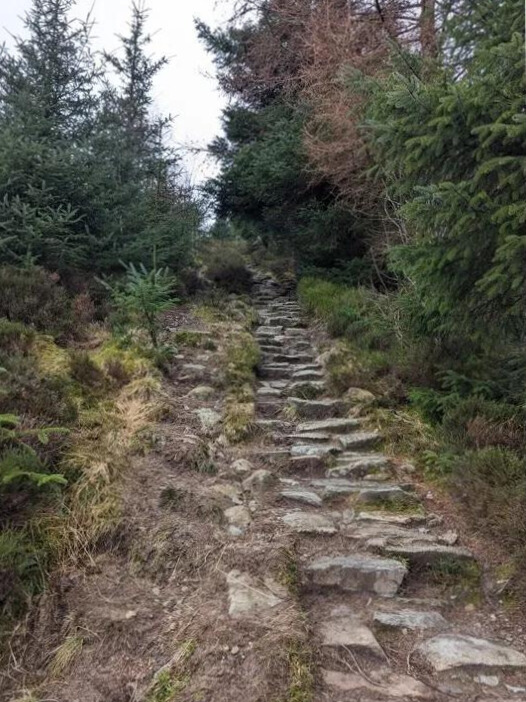Introduction: The call of the mountains
In the embrace of Scotland’s Trossachs National Park, beneath the towering presence of Ben Ledi, I found myself at the threshold of an adventure. This climb was more than a physical endeavour; it was a lesson about working with and not against the intrusive thoughts and images that threatened to undermine my confidence and progress. A lesson that was guided by components from Acceptance and Commitment Therapy (ACT).
For me, mountains are sanctuaries of solitude. Walking amongst them creates a synergy of body and mind, an immersion into the here and now, and a chance to achieve something tangible amidst the vastness of nature.
However, it had been some time since I last walked in the mountains due to an ankle injury and subsequent surgery. So, the decision to climb a peak so close to Munro status, less than a year after my surgery, filled me with both excitement and nerves. The ever-present ache in my Achilles was a constant reminder of what I had been through and what still lay ahead. Yet, my husband’s support and our pact to carefully listen to my body provided the assurance I needed to take the first step.
Embracing Uncertainty: Mindfulness Amidst the Mist
After a beautiful and slow ascent passing by loch Lubnaig, up stone steps winding through the hills, the clouds started to surround us, we couldn’t see the path ahead for more than a few meters. We climbed a little, with the wind rising, and patches of snow becoming frequent, my mind started to conjure images of potential disaster: “What if I fall and we can’t get mountain rescue?” Visions of my ankle rolling, akin to a past injury, flashed into my mind, amplifying my fear and anxiety. It was in this moment of vulnerability that I used two components from ACT: present moment awareness, and acceptance.

To steady my racing heart and quell the stirrings of panic, I turned to my breath — a natural anchor in tumultuous times. Recognising the rapid and shallow nature of my breathing, a common response to stress, I deliberately began to slow it down. Drawing upon a simple yet effective technique, I counted each inhalation and exhalation, progressively lengthening them: in for a count of three, out for the same, gradually increasing to five. I sustained this rhythm for several rounds, ensuring that I engaged my abdominal muscles and expanded my ribcage to invite a sense of calm.
I then turned to my environment — what could I see, hear, feel, and smell. This act of mindfulness allowed me to anchor myself in the present moment, shifting my attention from the whirlwind of ‘what ifs?’ to the ‘what is’. The majestic landscape, the eerie silence of the mist swirling around us, and the feel of the cold, snowy ground beneath me became my focal points. This deliberate shift in focus helped me to acknowledge my thoughts and feelings without being swept away by them. I started to pay attention to the knot in my stomach, recognising it for what it was, a part of my experience, not something to be vanquished but to be curious about. I stood up, feeling ready to continue, acknowledging the anxiety as part of my journey, not an enemy but a companion on the path to the summit.
Confronting the Summit of Self-Doubt: The Power of Defusion
Our journey to the summit was punctuated by moments of doubt, particularly as we encountered false summits that made the climb feel endless. Thoughts like “How stupid were you to come up here?” and “You’re not fit enough for this” surfaced, challenging my resolve. This is a common negative commentary I (and many of my clients) experience, so I know this story all too well. Rather than holding onto them tightly as if they’re absolute truths — known as fusing — I simply thanked my mind, and smiled.

This is just one of many defusion techniques taken from ACT that can be used to help gain distance from our internal narratives that are less than helpful. Defusion involves seeing our thoughts and feelings for what they are: mere words, images, and events, not laws that we must abide by or truths that dictate our actions. By offering a smile and a nod of gratitude to these passing thoughts, I diminished their influence over me, and as a by-product I felt less anxious. I repeated the same technique as similar thoughts arose, as we made our way to the summit and back down off the mountain and to the car. I often reminded myself that these thoughts, although unhelpful, are a natural part of being human, and they do not define my capability or the reality of my situation.
Conclusion: Navigating Life’s Mountains with ACT
Reaching the summit, and getting safely down to the car, became a moment of triumph: over the physical challenges of the climb and the mental and emotional barriers that had sought to deter me. This journey underscored the essence of ACT — accepting our thoughts and emotions without judgement, remaining present, and moving forward to do what matters to us. Just as we navigate the mountain’s terrain, so too can we navigate the complex landscape of our minds. How do you navigate the mountains of your minds? Are there certain techniques you find helpful?
If you want to learn more about anything I mentioned in this post, or would like to know more about how you might benefit from working with me, please reach out to me.

‘Embrace your demons, and follow your heart.’ Russell Harris
References
o Harris, R. (2006). Embracing your demons: An overview of acceptance and commitment therapy. Psychotherapy in Australia, 12, 70.
o Harris, R. (2019). ACT made simple: An easy-to-read primer on acceptance and commitment therapy (2nd ed.). New Harbinger Publications.
